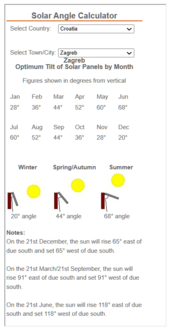Trntemrnte
New Member
CONSUMPTION
I checked my consumption in the apartment where I'm staying and for the last six-ish months it wasn't over 80kwh/month, which comes to 2,66kwh/day.
So just in case I've bumped that to 5kwh/day. Besides things I have now, that are using electricity, when I move off-grid I'll add to that a breadmaker(550w), which I'll use every 4-5 days, a water pump(some 400w), and a freezer(450w). Except for the freezer, the other two appliances will work rarely. The pump maybe for an hour a day, if that, and the breadmaker as said, a couple of hours every 4-5 days.
BATTERIES
So if I got it right, I'd need at least 10kwh of battery storage. I found LFP 51.2V batteries, 5120wh of capacity, that are produced in Europe, with a 10-year warranty. So it seems I'd need three of those if discharged up to 10% and to have some 2.5 days of backup for rainy days. In total some 15Kwh of capacity. An online calculator suggested I'd need 17.1kwh of storage, considering low(4C)winter temps. Is that correct?
PV PANELS
The calculator also suggested I need 2kw of PV panels at 4.1 hours of sunlight. I thought maybe I could add another 400w, as I'll probably have to go with three batteries.
INVERTER
I decided to buy all Victron devices, as I'm in Europe and they're a Dutch brand. So for the inverter, it seems MultiPlus 2 would work best. I'll have a generator connected to the inverter and MP2 has an integrated charger for this purpose.
MPPT CHARGER
The same calculator suggested I'd need 39amps for 2kw of panels. I saw Will saying it's always good to bump it up and also if I'd add that extra 400w for the total of 2.4kw of PV panels, then it comes to 50amps. I've found this Victron's MPPT 150/70. So that's 20amps more than needed, but according to specs it can charge up to 3440w, so I guess I could add more PV later on if needed, without having to upgrade the charger..?
GENERATOR
There's little info on this online, and I've been told many things that I've taken with a big grain of salt.
I know it can be automatic or manual, and that's about it.
QUESTIONS
Roughly, does 5kwh sounds enough?
Is battery sizing alright?
Is PV panels calculation correct? Should I add that extra 400w, for a total of 2.4kw?
Should I go with 3000VA or 5000VA MultiPlus2 for a system like this?
Is the calculation for the charger correct?
What generator would be the best bang for the buck? Auto vs manual pros and cons? I imagine those that have an auto-start option are more expensive.
Surely, any suggestions for further modifications are welcome as well.
I checked my consumption in the apartment where I'm staying and for the last six-ish months it wasn't over 80kwh/month, which comes to 2,66kwh/day.
So just in case I've bumped that to 5kwh/day. Besides things I have now, that are using electricity, when I move off-grid I'll add to that a breadmaker(550w), which I'll use every 4-5 days, a water pump(some 400w), and a freezer(450w). Except for the freezer, the other two appliances will work rarely. The pump maybe for an hour a day, if that, and the breadmaker as said, a couple of hours every 4-5 days.
BATTERIES
So if I got it right, I'd need at least 10kwh of battery storage. I found LFP 51.2V batteries, 5120wh of capacity, that are produced in Europe, with a 10-year warranty. So it seems I'd need three of those if discharged up to 10% and to have some 2.5 days of backup for rainy days. In total some 15Kwh of capacity. An online calculator suggested I'd need 17.1kwh of storage, considering low(4C)winter temps. Is that correct?
PV PANELS
The calculator also suggested I need 2kw of PV panels at 4.1 hours of sunlight. I thought maybe I could add another 400w, as I'll probably have to go with three batteries.
INVERTER
I decided to buy all Victron devices, as I'm in Europe and they're a Dutch brand. So for the inverter, it seems MultiPlus 2 would work best. I'll have a generator connected to the inverter and MP2 has an integrated charger for this purpose.
MPPT CHARGER
The same calculator suggested I'd need 39amps for 2kw of panels. I saw Will saying it's always good to bump it up and also if I'd add that extra 400w for the total of 2.4kw of PV panels, then it comes to 50amps. I've found this Victron's MPPT 150/70. So that's 20amps more than needed, but according to specs it can charge up to 3440w, so I guess I could add more PV later on if needed, without having to upgrade the charger..?
GENERATOR
There's little info on this online, and I've been told many things that I've taken with a big grain of salt.
I know it can be automatic or manual, and that's about it.
QUESTIONS
Roughly, does 5kwh sounds enough?
Is battery sizing alright?
Is PV panels calculation correct? Should I add that extra 400w, for a total of 2.4kw?
Should I go with 3000VA or 5000VA MultiPlus2 for a system like this?
Is the calculation for the charger correct?
What generator would be the best bang for the buck? Auto vs manual pros and cons? I imagine those that have an auto-start option are more expensive.
Surely, any suggestions for further modifications are welcome as well.





